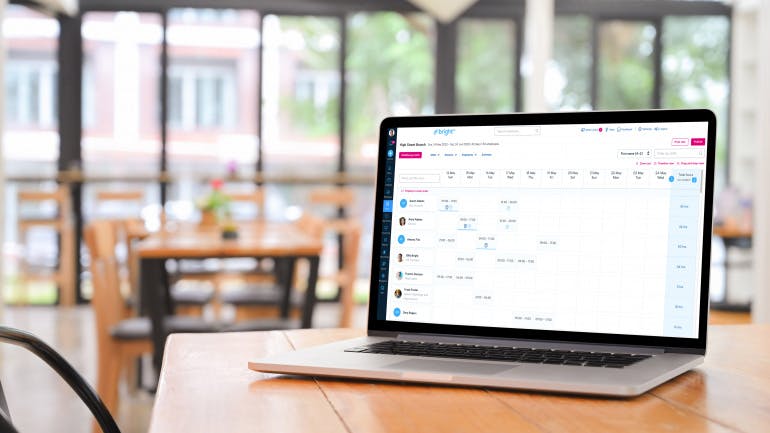First published on Thursday, June 4, 2020
Last updated on Friday, May 9, 2025
Jump to section
As the famous American pioneer Benjamin Franklin once said, “For every minute spent organising, an hour is earned.” And it’s true—a carefully organised staff rota can save you plenty of time and hassle.
So, it’s hardly surprising that companies across a broad range of industries make regular use of staff rotas. Read on as we highlight the difference that these scheduling tools can make in confirming and keeping track of employee availability.
What is a staff rota?
In simple terms, a staff rota may either be a digital or paper-based outline of who works when. You might also hear them referred to as “rosters” or “schedules” depending on where you’re based in the world.
These interchangeable terms each apply to the outlining of particular days and hours that staff members are set to work. Rotas should also highlight when staff are entitled to take breaks and when they’ll be off duty.
A staff rota could benefit your business in the following ways:
Boost staff satisfaction through the communication of clear and predictable work schedules
Enhance operational efficiency by aligning staffing levels with demand
Ensure the optimal use of staff resources (avoiding understaffing and overstaffing).
Key components of a staff rota
The setting of a rota isn’t just about filling slots on a calendar. It should take the form of a detailed work schedule that aligns with the availability of suitably skilled workers.
As an example, a restaurant schedule rota might be used to confirm and arrange the working hours of bartenders, baristas, chefs, and managers. You might also have to ensure the availability of extra staff, who can come in and cover in the event of absences or illnesses.
It might be best to set your rota out on a weekly, bi-weekly, or monthly basis depending on your business needs and worker preferences. There might also be scheduling constraints and other industry-specific factors that have a bearing on the appropriate choice of formatting. In any case, your rota should be clear and easy to understand.
Staff rotas commonly include these elements:
Names and roles of assigned staff
Dates and times for each shift
Confirmed days off and leave
Relevant notes and instructions
Agreed breaks and rest periods
Staff contact details, in case of last-minute changes or emergencies
Overtime availability (considering legal restrictions).
Time and care should be taken, with the rota being shared for staff to review some time in advance of their assigned shifts. Changes might be required to ensure the fair allocation of responsibilities and fulfil staff demands. It’s also a good idea to monitor the effectiveness of your rota and the impact of any changes based on your business aims.
You might find it helpful to create a shift rota template so that you don’t have to repeat the formatting each time.
It’s also a smart idea to assign a senior staff member with responsibility for rota management. They should write up the work schedules, confirm any shift swaps and update the rota accordingly. While staff feedback and suggestions should be encouraged, rota changes shouldn’t be made without authorisation.
Challenges of staff rotas
You might be met with some resistance if staff feel that your rota is unfair and doesn’t fully account for their needs. However, it should be possible to clear up such issues and misunderstandings provided that you share your rota in good time. Any scheduling conflicts or concerns should be dealt with at the earliest opportunity to avoid staff dissatisfaction and negative impacts on performance.
There’s also a balance to be met in fulfilling your business needs with consideration of employee preferences. You might have particular difficulty managing peak times, when you’ll be more reliant on staff to satisfy increased customer demand.
With that said, you should allow for some flexibility in your rota. It might be easier to accommodate changes in demand if you have part-time staff or employees who are able to perform a wide variety of duties.
Here are some best practices for the setting of staff rotas:
Ensuring fair distribution of the workload to avoid staff burnout and maintain productivity
Processing requests for time off, holidays, and shift swaps in good time
Creating contingency plans in case of unexpected changes and emergencies
Ensuring that the rota fits in with wider business goals and strategic plans.
Benefits of staff scheduling software
Thankfully you can overcome the challenges and ensure the most effective scheduling with shift and rota planning technology.
Designed for the easy creation of clearly formatted rotas, such technology enables you to avoid the errors associated with manual data entry. You can assign staff shifts and ensure that you have cover for the busiest times via your computer, tablet, or phone.
See what’s possible with staff scheduling software:
Create rotas in a clear table layout and send instant team notifications
Give staff the option of accepting or declining shifts based on their preferences and availability
Set up notifications to ensure that your staff know when shifts become available
Arrange for the cover of unfilled shifts on a first come first serve basis.
Allowing you to assign specific roles and track staff attendance, such scheduling software can be a real game-changer. It can help you stay compliant with Working Time Regulations, to avoid legal and financial penalties.
With a rota, you’ll also find it easier to organise night shifts, rest breaks, and overtime. Plus, it will reduce your stress in managing other people’s work, so you can focus on what you do best.
How BrightHR can help with staff rotas
The setting of a successful work rota calls for detailed planning and communication. However, the benefits can be realised by businesses and organisations across industries such as retail, healthcare, hospitality, and construction.
Staff scheduling software is the ideal solution for setting streamlined schedules, which will ensure the optimum use of staff time.
Book a personal demo of BrightHR today and discover how our rota planning tools can transform the management of your staff schedules.
Have a question?
Ask away, we’ve got lightning fast answers for UK business owners and employers powered by qualified experts.










